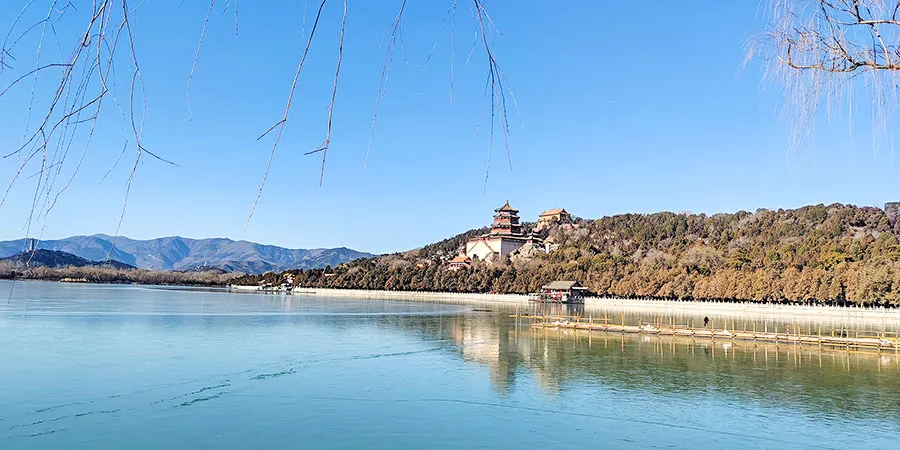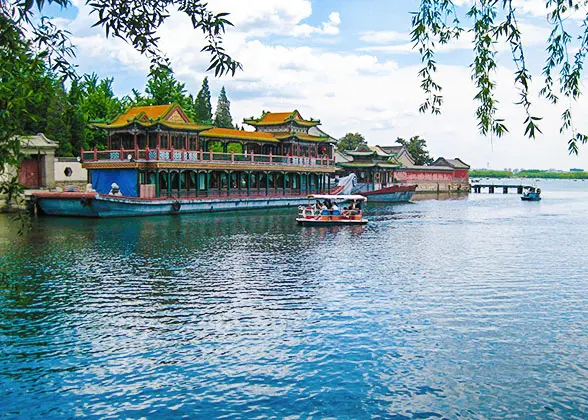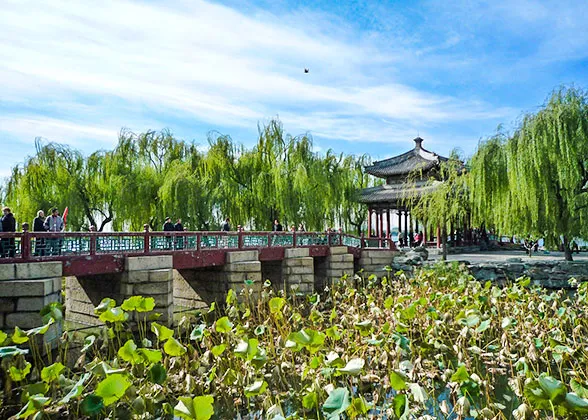Kunming Lake
Kunming Lake is a most attractive water feature a short distance from downtown Beijing, where it covers three quarters of the total area of the Summer Palace grounds. By virtue of Beijing’s topographical location, with a gradient sloping down from the northwest to the southeast, the lake is situated at the convergence of the hills and a plain. The ground water level gives rise to a number of natural springs that formed the embryo of what ultimately was to become this fine ornamental lake.
In the Yuan Dynasty (1277-1368), the Longevity Hill was called Weng Shan (Urn Mountain) because of its urn-like appearance. The low-lying land at the southern mountain foot accumulated water from springs of Jade Spring Mountain, and formed a sizable lake, known then as Wengshan Pool. During the Ming Dynasty (1368-1644), the name was changed to the ‘West Lake’. A causeway was built in the east side of the lake as a water control project. The capital city of the Ming moved from Nanjing to Beijing and many dignitaries and nobles chose to settle down in this area, for it was very similar to the terrain in South China. By the mid-Ming Dynasty, many private gardens had been established here. Emperor Qianlong of the Qing Dynasty (1644-1911) decided to build a new and truly impressive garden, even though several spectacular imperial gardens had been built during the reign of the former emperor. The new project was constructed on land formed by the dredging of a water channel and construction of a temple to mark the 60th birthday of Qianlong’s mother. (This temple was destroyed in 1860. Subsequently, it was rebuilt as the present Hall of Dispelling Clouds).

With an existing natural lake and hill, it is understandable that Emperor Qianlong could not resist the temptation of such a great garden. However, his proposal went beyond merely wanting a pleasure garden for his amusement. The imperial gardens in Beijing needed more water and there was always a flood risk during the rainy season should water overflow the causeway and threaten the imperial city to the east. The enlarged lake would meet all the criteria. In 1750, Qianlong declared the change of ‘West Lake’ to 'Kunming Lake’, a name that was reminiscent of the inspection by Emperor Han Wu of his navy in Kunming Pool.
The dredged lake was linked to the Jade Mountain Spring and moat in the city by two water channels. The east bank of the lake was extended and the excavated earth was moved to improve the terrain on the east flank of Longevity Hill. The temple on the east bank remained on what was to become an island – Nanhu Island, connected by the picturesque Seventeen-Arch Bridge to the newly reinforced causeway. The western reach of the lake is small and shallow so, later the West Causeway was built as an ancillary support to the vista on the western aspect of the garden. This narrow causeway was built mostly as an enhancement of the landscape. Six bridges in various styles broke up the monotony of the previously uninspiring view. Today, there is no lack of exquisitely designed attractions creating endless surprises around the lake. Next: Back Lake & Wanzihe
Next: Back Lake & Wanzihe
In the Yuan Dynasty (1277-1368), the Longevity Hill was called Weng Shan (Urn Mountain) because of its urn-like appearance. The low-lying land at the southern mountain foot accumulated water from springs of Jade Spring Mountain, and formed a sizable lake, known then as Wengshan Pool. During the Ming Dynasty (1368-1644), the name was changed to the ‘West Lake’. A causeway was built in the east side of the lake as a water control project. The capital city of the Ming moved from Nanjing to Beijing and many dignitaries and nobles chose to settle down in this area, for it was very similar to the terrain in South China. By the mid-Ming Dynasty, many private gardens had been established here. Emperor Qianlong of the Qing Dynasty (1644-1911) decided to build a new and truly impressive garden, even though several spectacular imperial gardens had been built during the reign of the former emperor. The new project was constructed on land formed by the dredging of a water channel and construction of a temple to mark the 60th birthday of Qianlong’s mother. (This temple was destroyed in 1860. Subsequently, it was rebuilt as the present Hall of Dispelling Clouds).

With an existing natural lake and hill, it is understandable that Emperor Qianlong could not resist the temptation of such a great garden. However, his proposal went beyond merely wanting a pleasure garden for his amusement. The imperial gardens in Beijing needed more water and there was always a flood risk during the rainy season should water overflow the causeway and threaten the imperial city to the east. The enlarged lake would meet all the criteria. In 1750, Qianlong declared the change of ‘West Lake’ to 'Kunming Lake’, a name that was reminiscent of the inspection by Emperor Han Wu of his navy in Kunming Pool.
|
|
The dredged lake was linked to the Jade Mountain Spring and moat in the city by two water channels. The east bank of the lake was extended and the excavated earth was moved to improve the terrain on the east flank of Longevity Hill. The temple on the east bank remained on what was to become an island – Nanhu Island, connected by the picturesque Seventeen-Arch Bridge to the newly reinforced causeway. The western reach of the lake is small and shallow so, later the West Causeway was built as an ancillary support to the vista on the western aspect of the garden. This narrow causeway was built mostly as an enhancement of the landscape. Six bridges in various styles broke up the monotony of the previously uninspiring view. Today, there is no lack of exquisitely designed attractions creating endless surprises around the lake.
![]() Related Link: Summer Palace Travel Tips
Related Link: Summer Palace Travel Tips
- Last updated on Aug. 01, 2025 by Gabby Li -

